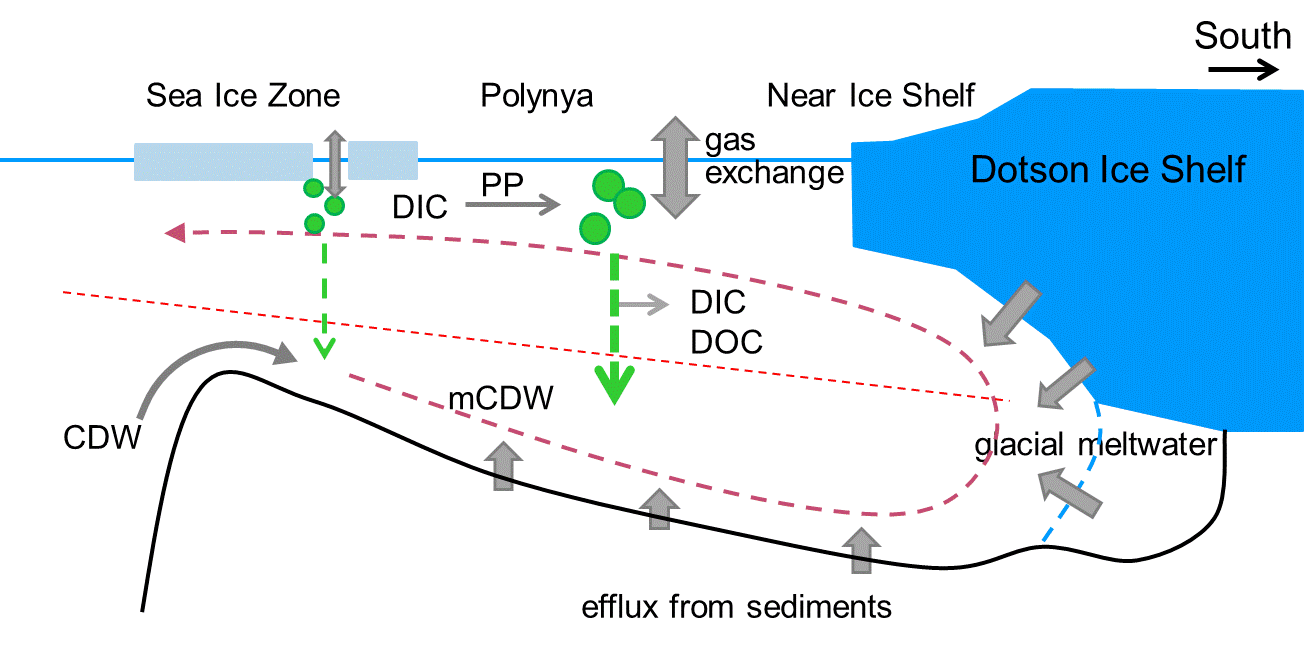Main Research Overview
-
입자 유기물이 생성된 후 해양에서 겪는 과정 연구
Processes particulate organic carbon undergoes in the ocean from primary production to sedimentation
-
용존 유기물 순환 연구
Dissolved organic carbon cycling based on radiocarbon
-
기후변화 등 외부의 물리적 요인에 대한 해양 탄소 순환의 반응
Impact of climate change on marine biological carbon pump
-
방사성탄소를 추적자로 이용하여 해양∙물리학적 과정 규명
Physical/chemical processes such as gas exchange and water circulation in the ocean based on radiocarbon of DIC
Research Tools
-
방사성탄소, Radiocarbon


-
탄소 순환을 추적하는 도구로 방사성 탄소를 이용하며, 가속질량분석기 (AMS)로 방사성탄소를 측정하기 위해
용존무기탄소, 입자유기탄소, 용존유기탄소 시료의 전처리 장치를 보유하고 있다.
Various forms of samples, i.e., DIC, POC, and DOC can be processed in our lab for radiocarbon measurements
-
지방계 바이오마커, Lipid biomarker

Agilent 7890B GC

Agilent 5977A MS
-
유기물의 기원을 밝히는데 다양한 지방계 바이오마커를 활용한다.
-
Agilent 7890A GC, Agilent 7890B GC, 5977A MS 를 이용하여 분석하며, Freeze dryer 및 MARS6 microwave lipid extractor 를 갖추고 있다.
Various lipid biomarkers are used to understand the sources of POC in the ocean. We mainly use Agilent GC and GC-MS
for chemical analysis
-
퇴적물 트랩, Sediment trap


-
퇴적물 트랩을 이용하여 심해 침강입자 시료를 채취한다.
-
수 개월에서 1년까지의 기간 동안 계류하여 시간에 따른 시료를 채집한다.
Sediment trap moorings are the main way to collect time-series sinking particle samples.
Main Research Interest
① 동해의 지리적 특성을 활용한 대양 용존유기탄소 순환
-
해양 용존유기탄소의 방사성탄소 연령은 심층 순환을 따라 증가하며 이는 용존유기탄소가 해양 순환을 수차례 반복할 것으로 예상되지만, 대양 표층 순환의 복잡성 때문에 북태평양에서 북대서양으로 용존유기탄소의 재순환 과정 연구에는 어려움이 있었다.
-
북서태평양과 동해는 얕은 해협으로 연결되어 표층수 교환만이 이루어지므로, 이러한 동해의 지리적 특성을 이용하여 용존유기탄소의 순환을 연구한다.
The radiocarbon age of dissolved organic carbon (DOC) in the ocean increases along deep circulation pathways, suggesting
that DOC may undergo multiple cycles through oceanic circulation. However, due to the complexity of surface circulation,
studying the re-circulation of DOC from the North Pacific to the North Atlantic has been challenging.
The northwestern Pacific and the East Sea (Sea of Japan) are connected by shallow straits, allowing only surface water
exchange. This geographical characteristic of the East Sea can be leveraged to study the circulation of dissolved organic
carbon.
② 해양에서 퇴적물의 재부유로부터 기인하는 입자유기물의 침강입자에 대한 기여도 파악


-
표층 해수의 일차 생산에서 기원하는 입자 이외에, 재부유된 퇴적물의 수평적인 이동에 의한 기여가 총 침강입자유기물의 어느 정도를 차지하는지 방사성탄소를 이용하여 연구한다.
-
퇴적물을 대표하는 알루미늄 농도와 방사성탄소 함량 사이의 상관 관계로부터 재부유된 퇴적물의 침강입자에의 기여가 상당함을 밝히고 서로 다른 해양 환경에서 퇴적물 재부유의 생물에 대한 영향을 연구한다.
Lateral transport of resuspended sediment appears to contribute to sinking particles in the ocean significantly in most
ocean settings. Radiocarbon content of sinking POC and Al content of sinking particles show a negative correlation
supporting the contribution of resuspended sediment as a main cause for lower radiocarbon content in sinking POC than
expected if primary production in the overlying surface water is the only source of sinking POC.
③ 남극 아문젠해의 생물학적 펌프와 무기탄소, 유기탄소 순환
.jpg)

S. Oh et al. 2025
-
남극 아문젠해는 급격한 해빙 감소를 겪고 있는 해역으로 따뜻한 CDW (Circumpolar Deep Water)가 대륙붕으로 유입되는 곳이다. 남극 주변에서 가장 높은 일차생산성을 보이는 아문젠해 폴리냐가 열리는 동안 일차생산에 의한 대기중 이산화탄소의 흡수, 생물학적 펌프의 작동과 이에 따른 용존유기탄소와 용존무기탄소의 순환과정을 연구한다.
The Amundsen Sea in the west Antarctic experiences rapid physical change such as decline in sea ice cover and rapid
melting of ice shelves. The intrusion of the Circumpolar Deep Water is a main feature of the water circulation on the
Amundsen Shelf.
We study the biological pump system and concurrent DIC and DOC cycling in the Amundsen Sea.

